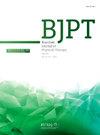肩胛骨运动学变异性在有或没有肩袖相关肩痛的个体中:一项多水平meta回归的系统综述
IF 3.2
3区 医学
Q1 ORTHOPEDICS
引用次数: 0
摘要
传统上,在治疗肩袖相关性肩痛(RCRSP)患者的方法中,肩胛骨运动异常一直是非常重要的。目的回顾有关RCRSP患者和非RCRSP患者肩胛骨位置和运动变异性的文献。方法于2024年4月18日对9个数据库进行系统检索。评估健康个体和RCRSP患者手臂抬高过程中肩胛骨运动学的研究被纳入其中,重点是3D非表面跟踪系统。结果共纳入20项研究。在无症状个体中,估计肩胛骨静止位置为向上旋转1.00°至11.58°,前倾4.82°至11.24°,内旋26.84°至39.05°。在上臂过程中,肩胛骨从最开始(无固定阶段)向UR(最终位置,150°仰角时47.88°至61.00°)和后倾(最终位置,150°仰角时10.78°至11.96°)移动,并有向外旋转的趋势。胸骨抬高和肩胛骨UR的估计肩胛骨节律范围为2.86:1至3.13:1。RCRSP患者在UR的肩胛骨静止位置(平均差值,-6.11°;95% CI: -7.36°,-4.86°)和内旋(平均差值,4.21°;95% CI: 0.68°,7.74°)的差异证据的确定性非常低,低于95%预测区间的宽度。结论:这项荟萃分析已经揭穿了设定阶段和恒定3:1肩胛骨节律的神话。肩胛骨运动学有很大的可变性,这使得检测异常模式变得困难。普洛斯彼罗注册号crd42021259479本文章由计算机程序翻译,如有差异,请以英文原文为准。
Scapular kinematics variability in individuals with and without rotator cuff-related shoulder pain: A systematic review with multilevel meta-regression
Background
Traditionally, great importance has been placed on abnormal scapula kinematics in the approach to treatment of patients with rotator cuff related shoulder pain (RCRSP).
Objective
To review the literature regarding the variability of scapular position and movement in individuals with and without RCRSP.
Methods
A systematic search was performed on 18th April 2024 on nine databases. Studies evaluating scapular kinematics during arm elevation in healthy individuals and those with RCRSP were included, with a focus on 3D non-surface tracking systems.
Results
Twenty studies were included. In asymptomatic individuals, the estimated scapular position at rest was 1.00° to 11.58° of upward rotation (UR), 4.82° to 11.24° of anterior tilt, and 26.84° to 39.05° of internal rotation. During arm elevation, the scapula moves from the very beginning (no setting phase) towards UR (final position, 47.88° to 61.00° at 150° of elevation) and posterior tilt (final position, 10.78° to 11.96° at 150° of elevation), and there is a trend towards external rotation. The estimated scapulohumeral rhythm for humerothoracic elevation and scapular UR ranged from 2.86:1 to 3.13:1. There was very low certainty of evidence for differences in individuals with RCRSP in scapula resting position for UR (mean difference, -6.11°; 95 % CI: -7.36°, -4.86°), and internal rotation (mean difference, 4.21°; 95 % CI: 0.68°, 7.74°), that were below the width of the 95 % prediction intervals.
Conclusion
This meta-analysis has debunked the myth of the setting phase and the constant 3:1 scapulohumeral rhythm. There is great variability in scapular kinematics, making it difficult to detect abnormal patterns.
Prospero registration number
CRD42021259479
求助全文
通过发布文献求助,成功后即可免费获取论文全文。
去求助
来源期刊
CiteScore
6.10
自引率
8.80%
发文量
53
审稿时长
74 days
期刊介绍:
The Brazilian Journal of Physical Therapy (BJPT) is the official publication of the Brazilian Society of Physical Therapy Research and Graduate Studies (ABRAPG-Ft). It publishes original research articles on topics related to the areas of physical therapy and rehabilitation sciences, including clinical, basic or applied studies on the assessment, prevention, and treatment of movement disorders.

 求助内容:
求助内容: 应助结果提醒方式:
应助结果提醒方式:


